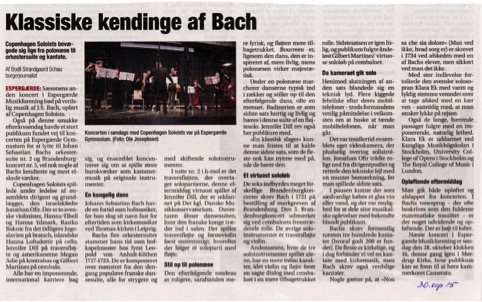Classical evergreens by Bach
Copenhagen Soloists swayed through from Polonaise to orchestra suite and cantata.
Bodil Strandgaard Schau (Helsingør Dagblad, 30 September, 2015)
ESPERGÆRDE: The season’s second concert at Espergærde Music Society offered secular music by J.S. Bach, performed by Copenhagen Soloists.
Also on such a beautiful autumn day a large audience had found its way to the concert at the Espergærde Highschool hall to listen to Johann Sebastian Bach’s orkestral suite nr. 2 and Brandenburg concerto nr. 5, probably amongst Bachs most well-known and beloved works.
Copenhagen Soloists played under the directorship of the ensemble’s conductor and founder, the Israeli-born Jonathan Ofir. The two Swedish violinists, Hannah Tibell and Hanna Ydmark, Rastko Roknic from the former Yugoslavia on viola, Icelandish Hanna Loftsdottir on cello, Jennifer Dill on traverse flute and American Megan Adie on double-bass and Gilbert Martinez on harpsichord.
All have impressing, international carriers behind them, and the ensemble concentrates on playing large-scale baroque works in chamber-musical fashion on period instruments.
A royal dance
Johann Sebastian Bach had been a court musician, before engraving his name for posterity as a church musician during his post at the St. Thomas church in Leipzig.
Bach’s four orchestral suites originate from his time as court chapel-master for Leopold von Anhalt- Köthen 1717-1723. They are composed according to a grid of the then-popular French dance suite, all of them for strings with varied solo instruments.
In suite nr. 2 it is the traverse flute that covers the solo parts, this afternoon virtuosically played by Jennifer Dill, who studied at the Royal Danish Music Conservatory. The overture opens the dance suite, where the French king enters the hall. Here the traverse flute and first violin play first in unison, where afterwards a solo part with flute ensues.
Eminent Polonaise
The following Rondeau is more calm, the Sarabande more lyrical, and the flute less prominent. The Bourée is, as the dance which it is inspired by, more lively, whilst the Polonæse appears majestic in nature.

During a Polonaise the dancers typically march in in rows and set up for the following dance, often a minuet. Badinerie as the concluding movement is quick and lively and is carried forth in this suite by a flute solo. Jennifer Dill swept the audience also here.
”A classical hit” one might be lured to call this last movement, which most would probably be able to hum when they hear it.
Virtuoso solo passages
The six respective, and very different, Brandenburg concertos were composed by Bach in 1721 upon commission of the Field Duke of Brandenburg. The 5th Brandenburg concerto is distinguished by the harpsichord’s prominent role. The other solo instruments are traverse flute and violin.
The second movement, where the three solo instruments play on their own, has a more intimate character, in that the violin and flute conduct a muted dialogue with the harpsichord in a more held back role. The final movement is again lively, and the audience followed breathlessly Gilbert Martinez’s virtuoso solo passages on the harpsichord.
When the camera went solo
Towards the end of the second movement a technical noise interfered. Several people looked feverishly at their cellphones – despite the chairman’s kind reminding to turn on the phones after the concert.
It turned out to be the ensemble’s own video camera, which suddenly took over the solo role. Jonathan Ofir stepped down calmly from the conductor stage and fixed the technical problem with a jovial remark, before continuing with the final movement. Im the break one could as usual buy a glass of wine or other beverage, and there was opportunity for sharing of musical experiences amongst the audience.
Bach probably composed nearly 300 cantatas (of which just over 200 have been found). Most are church cantatas, and nowadays one would mostly relate the term to church music, but Bach had also composed secular cantatas.
Som guess, that ”Non sa che sia dolore” (One knows not what sorrow is) was composed in 1734 as a farewell cantata for one of Bach’s students, but one is not certain.
With great passion, as well as a warm and rich voice, the Swedish soprano Klara Ek conveyed the sorrow of the separation from a dear friend – whilst one wishes them success in their journey.
Also the long, bearing passages flowed with an impressing, natural lightness. Klara Ek has studied at the Royal High School of Music in Stockholm, University College of Opera in Stockholm and The Royal College of Music in London.
Uplifting afternoon
The concert left one both uplifted and relaxed. In Bach’s tonal language – which is often described as the ultimate mathematical tonality – there is something expansive and uplifting. The ceiling seems elevated.
The next concert at Espergærde Music Society is on Sunday the 18th October 4PM, this time at Mørdrup Church, where the public can look forward to hearing Camerata chamber choir.
